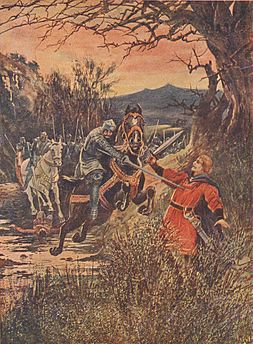Llywelyn ap Gruffudd facts for kids
Quick facts for kids Llywelyn ap Gruffudd |
|||||
|---|---|---|---|---|---|
| Prince of Aberffraw Lord of Snowdon |
|||||
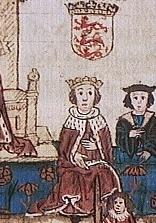
Contemporary depiction
|
|||||
| Prince of Wales | |||||
| Reign | 1246–1282 | ||||
| Predecessor | Dafydd ap Llywelyn | ||||
| Successor | Dafydd ap Gruffydd | ||||
| Born | c. 1223 Gwynedd, Wales |
||||
| Died | 11 December 1282 Aberedw, Powys, Wales |
||||
| Spouse | Eleanor de Montfort | ||||
| Issue | Gwenllian of Wales Princess Catherine |
||||
|
|||||
| Royal house | Aberffraw | ||||
| Father | Gruffydd ap Llywelyn Fawr | ||||
| Mother | Senana ferch Caradog | ||||
Llywelyn ap Gruffudd (born around 1223 – died December 11, 1282) was a very important leader in Wales. He was known as Llywelyn the Last because he was the last native Prince of Wales before England took control. He ruled from 1258 until his death in 1282. Llywelyn was the grandson of Llywelyn the Great, another famous Welsh prince. He fought hard to keep Wales independent from King Edward I of England.
Contents
Llywelyn's Early Life and Family
Llywelyn was the second of four sons born to Gruffydd and Senana ferch Caradog. His grandfather was the famous Llywelyn the Great. Llywelyn had two younger brothers, Dafydd ap Gruffydd and Rhodri ap Gruffydd, and an older brother, Owain Goch ap Gruffydd. He was probably born around 1222 or 1223.
After his grandfather died in 1240, Llywelyn's uncle, Dafydd ap Llywelyn, became the ruler of Gwynedd. Llywelyn's father and older brother were held prisoner by his uncle, and then by King Henry III of England. Sadly, Llywelyn's father died in 1244 while trying to escape from the Tower of London. This event helped Llywelyn's uncle, Dafydd, in his fight against King Henry. Llywelyn supported his uncle in these battles. When Dafydd died in 1246 without children, Llywelyn was in a good position to take over.
Becoming a Ruler
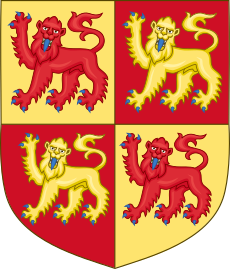
Llywelyn and his brother Owain made a deal with King Henry III in 1247. This was called the Treaty of Woodstock. They had to accept that their lands in Gwynedd would be smaller. The land west of the River Conwy was split between Llywelyn and Owain. The land east of the river was taken by King Henry.
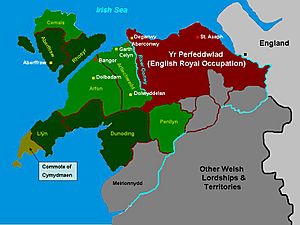
When Llywelyn's younger brother, Dafydd, grew up, King Henry wanted to give him part of Gwynedd too. Llywelyn did not agree. Owain and Dafydd then teamed up against Llywelyn. This led to a battle in June 1255 called the Battle of Bryn Derwin. Llywelyn won and captured both his brothers. This made him the sole ruler of Gwynedd west of the Conwy River.
Llywelyn then wanted to make his territory bigger. Many people in Gwynedd east of the Conwy River were unhappy with English rule. In November 1256, Llywelyn crossed the river with his army, and his brother Dafydd, whom he had released, joined him. By December, Llywelyn controlled most of Gwynedd east of the Conwy. An English army tried to fight back but was defeated by Llywelyn's forces in June 1257.
By 1258, Llywelyn began using the important title of Prince of Wales. However, the English king refused to accept this title. In 1263, Llywelyn's brother, Dafydd, switched sides and joined King Henry.
In England, a powerful lord named Simon de Montfort fought against King Henry. Llywelyn started talking with de Montfort. In 1265, they made a deal called the Treaty of Pipton. This treaty said that Llywelyn had the right to rule Wales. However, Simon de Montfort died in battle later that year.
Llywelyn's Greatest Power

After Simon de Montfort died, Llywelyn quickly gained more land and power. He captured Hawarden Castle and defeated English armies. Because of his victories, King Henry III finally recognized Llywelyn as the Prince of Wales in the Treaty of Montgomery in 1267. This was a huge moment for Llywelyn. He kept the lands he had conquered and almost all Welsh rulers accepted him as their lord. In return, he had to pay a large sum of money to the English king.
But problems soon started. There was a disagreement with an English lord, Gilbert de Clare, over land. Gilbert built Caerphilly Castle because of this. Also, Llywelyn found it hard to pay the yearly money he owed to King Henry. He stopped making payments.
When King Henry died in 1272, his son Edward I became king. Edward was a strong ruler and a rival of Llywelyn. In 1274, Llywelyn's brother, Dafydd, and another Welsh lord, Gruffydd ap Gwenwynwyn, plotted to kill Llywelyn. The plot failed, and Dafydd and Gruffydd fled to England. They then raided Llywelyn's lands, which made Llywelyn even more angry. When King Edward asked Llywelyn to come to England to show his loyalty, Llywelyn refused.
Llywelyn also upset King Edward by wanting to marry Eleanor de Montfort, the daughter of Simon de Montfort. Eleanor was actually King Edward's cousin. In 1275, Eleanor sailed from France to meet Llywelyn, but King Edward sent pirates to capture her ship. She was held prisoner at Windsor Castle until Llywelyn agreed to Edward's demands.
In 1276, King Edward declared Llywelyn a rebel. In 1277, Edward gathered a huge army to attack Llywelyn. Many smaller Welsh princes who had supported Llywelyn now made peace with Edward. Edward's army took control of lands east of the Conwy River and even captured Anglesey. This cut off Llywelyn's food supply, forcing him to seek peace.
The Treaty of Aberconwy
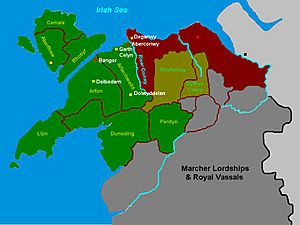
The peace agreement was called the Treaty of Aberconwy. It meant Llywelyn's power was much smaller. He could only rule Gwynedd west of the Conwy River. Part of the land east of the Conwy was given to his brother Dafydd. Llywelyn also had to accept King Edward as his ruler.
Llywelyn went to meet Edward and found Eleanor staying with the royal family. After Llywelyn agreed to Edward's terms, Edward allowed them to marry at Worcester Cathedral. People say their marriage was a true love story. Llywelyn and Eleanor had one daughter, Gwenllian of Wales.
Llywelyn's Last Fight and Death
By 1282, many Welsh princes who had supported Edward were unhappy with his rule. On Palm Sunday that year, Llywelyn's brother Dafydd attacked Hawarden Castle. This started a big revolt across Wales. Castles were captured, and rebellions spread.
Llywelyn said he wasn't involved in planning the revolt, but he felt he had to support his brother. This started a war that the Welsh were not ready for. Llywelyn also faced a personal tragedy: his wife, Eleanor, died in June 1282 shortly after giving birth to their daughter, Gwenllian.
King Edward's forces once again captured lands east of the Conwy and Anglesey. The Archbishop of Canterbury tried to make peace between Llywelyn and Edward. Llywelyn was offered land in England if he gave up Wales. But Llywelyn refused, saying he would not abandon his people.
Llywelyn left Dafydd to defend Gwynedd and went south to gather more support. On December 11, 1282, he was killed at the Battle of Orewin Bridge near Builth Wells. The exact details of his death are not clear, but both stories agree that he was separated from his army and then attacked and killed. One story says he was tricked into leaving his main army and was struck down by a single soldier. Another story says he was ambushed in a wood. An English knight later recognized his body.
Llywelyn's personal seal and those of his wife and brother Dafydd were later melted down by the English to make a special cup.
The poet Gruffudd ab yr Ynad Coch wrote a sad poem about Llywelyn's death, showing how much he was missed.
Wales Under English Rule
After Llywelyn's death, the Welsh people lost hope. His brother Dafydd tried to continue the fight for a few months, but he was captured in June 1283. He was taken to Shrewsbury and sentenced to death.
After the defeat in 1283, King Edward I took all the royal symbols and treasures from Gwynedd. He even moved his court to Llywelyn's royal home. Edward wanted to show that the Welsh princes were no longer in charge and that Wales now belonged to the English Crown.
Most of Llywelyn's family ended up in prison. His baby daughter, Gwenllian of Wales, was captured by Edward's soldiers in 1283. She was sent to a priory (a type of monastery) in England and lived there for the rest of her life, becoming a nun. She died in 1337, probably not knowing much about her Welsh heritage. Dafydd's two sons were also captured and died in prison.
Llywelyn's brother Rhodri, who had left Wales earlier, survived and lived in England. His grandson, Owain Lawgoch, later claimed the title of Prince of Wales.
Family Tree
| Llywelyn the Great 1173–1195–1240 |
|||||||||||||||||||||||||||||||||||||
| Gruffydd ap Llywelyn 1198–1244 |
Dafydd ap Llywelyn 1212–1240–1246 |
||||||||||||||||||||||||||||||||||||
| Owain Goch ap Gruffydd d. 1282 |
Llywelyn ap Gruffydd 1223–1246–1282 |
Dafydd ap Gruffydd 1238–1282–1283 |
Rhodri ap Gruffydd 1230–1315 |
||||||||||||||||||||||||||||||||||
| Gwenllian of Wales 1282–1337 |
Llywelyn ap Dafydd 1267–1283–1287 |
Owain ap Dafydd 1275–1287–c. 1325 |
Tomas ap Rhodri 1300–1325–1363 |
||||||||||||||||||||||||||||||||||
See also
 In Spanish: Llywelyn ap Gruffydd para niños
In Spanish: Llywelyn ap Gruffydd para niños


